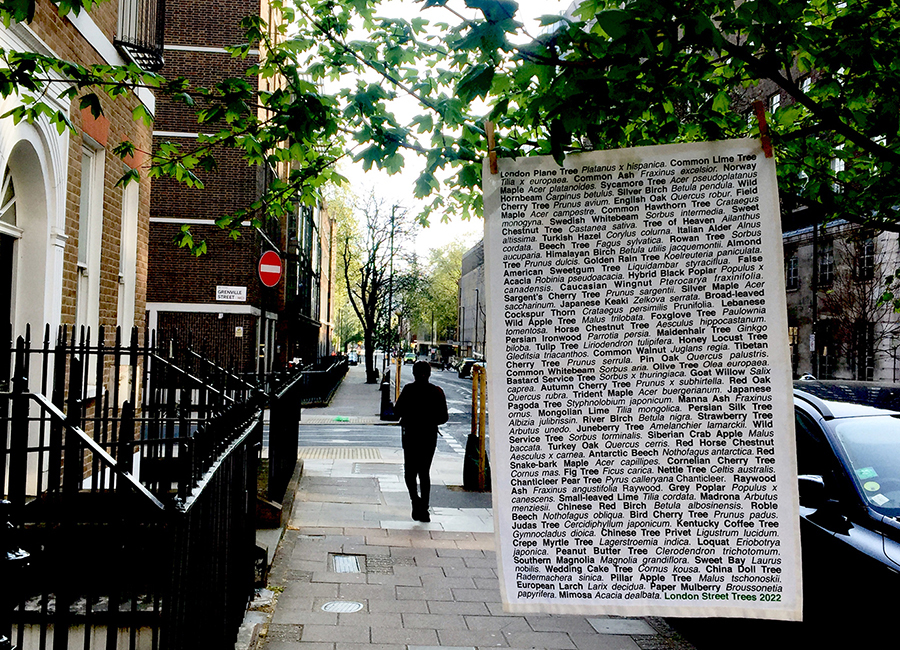

This pandemic year the tree watching and identifying became a mental life line. Pacing around central London now often alone, the deserted streets were redefined by its trees and the passing of time registered through their seasonal changes. These local characters had become my new steadfast companions!
To celebrate them and with a desire to make things (however small) in lockdown I started to play with regrouping tree characteristics across different genus to reflect emotional states such as fear, love and loss and also family connections. This became a series of 30 engraved necklaces starting with Weeping Trees and Memento Mori (Ash Dieback) and including Hybrid Trees (with my favourite the Bastard Service Tree) Pioneer Trees and Early European Settlers, Silver and Golden Trees, Fruit and Nut Trees, Biblical Trees, Trees with Thorns and Trees with Heart-shaped Leaves.
Later came tree necklaces reflecting my local shopping streets such as Lamb’s Conduit and Marchmont Streets in Bloomsbury, and also some favourite parks such as Lloyd Park in Walthamstow. The necklaces are made with engraved offcuts of traffolye from an industrial sign writer and reference directly botanical garden tree ID labels.
Last week I finished a Columbia Road tree necklace to give to my friend and fellow tree explorer Ingrid from Bethnal Green. It includes the now absent Fig Tree she mentioned that was cut down for new housing at the Shoreditch end of the road. Luckily she had taken cuttings from it for her nearby school vegetable garden.
I have never seen Ingrid wear a necklace but maybe this will be the first and she will enjoy carrying her local trees close to her heart. With thanks to Bettina, Graham, Ingrid, Nick, Daniel, Maureen and John for sharing the tree love.
https://urbantreefestival.org/news/tree-necklaces

For over 30 years of living in London, I had been more or less unaware of the street trees, seeing them as a green backdrop to city life. Occasionally individual trees would register, such as cherry trees in the spring but generally I just looked through or around them.
Joining a Saturday tree group was the start of an awakening as I began to learn how to recognise specific trees. It was often not a straightforward process and demanded a certain type of attention and sensitivity to analyse the trees characteristics. This new, slower and experiential way of looking zoned in on detail and comparisons and soon I was becoming hyper-tuned into individual species. The street trees were now in the forefront of my vision and had come to life! It took me by surprise how learning their names changed and enriched my relationship with the urban surroundings. They started to define how I navigated my local streets, using the trees as markers in the urban arboretum. Going to the shops became a tree journey: right at the newly planted Tassel Cherry trees, left down the alley with the struggling ash on the corner, across the big road shaded by London Planes, straight on and then left again into the street of mature pagoda and fig trees. On night time walks I photographed the trees, checking their names on the councils Trees in Camden Map, enjoying their heightened theatricality under the street lights.
My tree mentor Bettina insisted on the Latin names being used for accurate identification. I resisted for a while but then realised how these names were also full of clues and descriptions of the trees attributes and histories and demonstrated which were closely related. I drew up a list of all the trees closest to my home to act as an additional learning aid, extending outwards in every direction and then adding distinctive trees from my tree walk notebook. The list numbered over 80 different trees! Each name helped visualise a distinct tree, its leaves, bark and flowers.
The names indicated just how international London street trees were, including Turkish Hazel, Swedish Whitebeam, Chinese Tree Privet, Lebanese Wild Apple, Tibetan Cherry, Antarctic Beech and the Caucasian Wingnut. The Olive (Olea x europaea) announced its European origins and the London Plane (Platanus x hispanica) revealed its Spanish connections as the place where its parents, the Oriental Plane and the American Sycamore, hybridised in the 17th century. A few trees were named by their resemblance to another such as the Sycamore (Acer pseudoplatanus) and the False Acacia (Robinia pseudoacacia).
Numerous references to the senses were apparent, with colour included in the Silver Birch, Grey Poplar and Golden Rain trees and smell suggested with the leaves of the Peanut-butter Tree (Clerodendron trichotomum) The size and heart-shaped leaves of the Small-leaved Lime (Tilia cordata) compared with the hairy leaf undersides of the Silver Lime (Tilia tomentosa) Links to animals and flowers included the Red Snake-bark Maple (Acer capillipes) with its delicate, wriggly lines running up the trunk and the American Tulip Tree, named after the yellow-green-orange cup-shaped flowers in early summer. The name for the Persian Ironwood (Parrotia persica), originating from Iran and Azerbaijan, indicated its extremely tough timber.
Connections were made to our troubling histories with the Madrona (Arbutus menziesii) named after Archibald Menzies ‘discovery’ of the tree during the 18th century. Unsurprisingly there was only one tree named after a woman, the fast growing Foxglove or Empress Tree (Paulownia tomentosa) honouring Anna Paulownia, the 19th century Russian empress. Some Latin tree names sounded fantastic when said out loud including Ailanthus altissima, the Tree of Heaven and also Liquidambar styricifolia, the Sweet Gum. My tree name journey resulted in making a tea towel to celebrate Londons street trees indoors. It’s called From all over the World, reflecting the trees and people of London.
